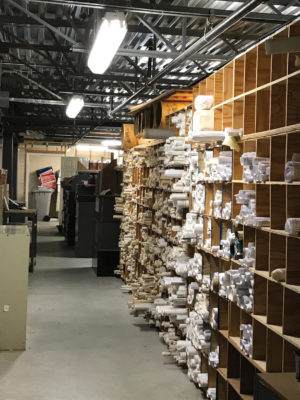
As you can imagine, the volume of folders, flat plans, rolled plans and field books from 168 years of work requires a substantial amount of physical space; and if not stored correctly, those historical documents could become damaged and even lost forever. Proper cataloging also is paramount for retrieval and use of the documents. The solution was to bring on Travis Yacovitch as a full-time Archivist to digitize and catalog the thousands of historical records as well as the new ones that are continually being created by the firm.
Travis’ journey to Hancock Associates and his work there is an interesting story.
While pursuing my Master’s degree, a longtime friend of mine who was a land surveyor at Hancock Associates told me that the firm was looking for an Archivist. I left the Thoreau Institute Library to take the position and continued my studies at Simmons University through their online program. I graduated from Simmons with a Master of Science Degree in Library and Information Science with a concentration in Archival Management. All of my education and experience is put to work at Hancock.
When looking at a large volume of materials, it can be tempting to work as quickly as possible. However, when it comes to archiving, quality and accuracy is far more important than speed. I will scan a piece as many times as I think is needed because I want to be sure that I save the best result possible. It takes time to handle each piece correctly but it’s time well spent. An original document will deteriorate over time and is at risk of being damaged or lost starting from the day it was created. With a digital file, the information is captured forever.
Creating the digital file is only part of the archiving process. The organization and storage of files is just as important. The information serves no useful purpose if it is not easily found. This is true for the physical archives and the digital ones. Over the years at Hancock, I have learned a great deal about land surveying which allows me to properly assess and organize materials.
Our files in our physical archive are organized by the name of the company in which they originated, the content and the document format, then stamped with a reference number. The digital archive, which is stored within our in-house computer network and backed up daily, is similarly structured and is easily searchable through a proprietary database. The database uses geotagging whereby common street addresses are converted to longitude and latitude coordinates for maximum accuracy. I also created a searchable satellite map of sites which allows Hancock project managers to easily look up previous surveys to get information. It can easily save hours of field and research work.
I’ve been Hancock’s full-time Archivist for over three years now and have digitized thousands of land surveying and civil engineering records…and counting. If you have questions about preserving history through archiving, feel free to reach out.
Travis Yacovitch is a full-time Archivist at Hancock Associates. You can connect with him at linkedin.com/in/travisyacovitch/